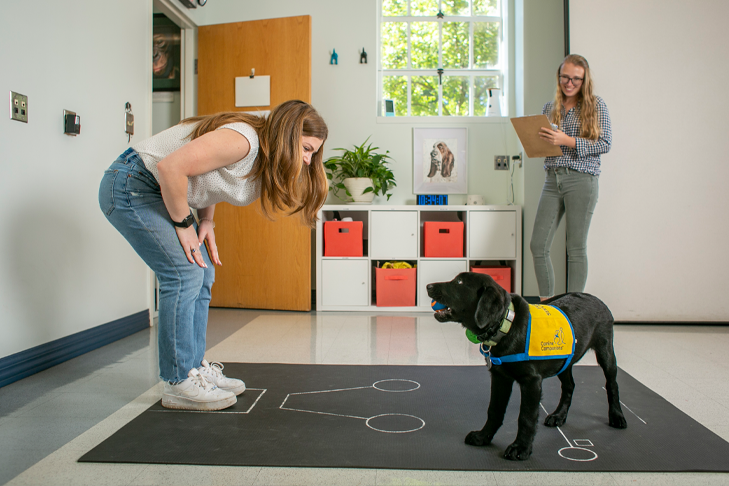Anyone who has raised a puppy knows that their adorable antics and playful behavior often hide a fascinating, rapidly developing mind. But what goes on inside a puppy’s head as they grow? Are all puppies alike in how they learn, or do they each have their own unique cognitive path? A team of researchers from Duke University, led by Vanessa Woods and Dr. Brian Hare, set out to answer these questions in a groundbreaking study of 101 puppies. Their findings, outlined in the book Puppy Kindergarten, reveal some surprising insights into how puppies develop and how their brains function during those crucial early weeks of life.
Why Study 101 Puppies?
The goal of the Duke University study wasn’t simply to satisfy curiosity about puppies’ minds, but to uncover patterns that could help match dogs with appropriate careers. Specifically, Woods and Dr. Hare wanted to understand why some dogs thrive as service dogs, while others fail to meet the demanding standards of training programs. To explore this, they enrolled 101 Labrador Retriever puppies, all bred by Canine Companions, one of the world’s largest and most respected service dog organizations.
The puppies were raised in two different environments: 52 on the Duke University campus and the rest in volunteer homes with Canine Companions. Over the course of several months, these puppies underwent a series of cognitive tests, designed to assess their problem-solving abilities and overall mental development. These “tests” weren’t your typical lab experiments; they were actually fun, engaging games like fetch or hiding treats to observe how the puppies responded.
Puppy Brain Development: More Complex Than You Think
Dr. Hare and Woods discovered that the development of a puppy’s cognitive abilities isn’t as simple as flipping a switch. In fact, the traditional notion of intelligence, where dogs either excel or struggle across the board, doesn’t quite apply to puppies. Instead, they adopted a more nuanced approach based on the theory of multiple intelligences. This theory suggests that intelligence isn’t a single, measurable trait but rather a collection of different abilities that can develop independently of each other.
For instance, a puppy might excel at understanding human gestures but struggle with more abstract tasks, like solving basic physics problems. Woods explains that puppies don’t develop all of their cognitive abilities at once, but instead, these abilities emerge gradually. As puppies grow, certain skills, like self-control, emerge later on in their development, much like how humans mature at different rates.
The Development of Puppy Intelligence
The study revealed that puppies develop different kinds of intelligence at varying stages of their growth. One of the most surprising findings was that puppies could understand human gestures, such as pointing, before they could grasp more complex concepts like basic physics. At just 8 weeks old, the puppies were able to respond to human gestures better than some of our closest relatives, like chimpanzees or bonobos.

It wasn’t until the puppies reached 10 weeks of age that self-control began to show. Before this, puppies would often act impulsively—chasing treats or getting distracted by anything that moved. The ability to focus and inhibit their impulses, such as resisting the temptation to grab a treat hidden in a tube, emerged gradually between 12 and 14 weeks. By the time the puppies reached this age, they also began to grasp basic concepts of physics, like understanding that a bowl was hidden under a towel shaped in a bowl form, rather than flat.
However, not every puppy developed these abilities at the same pace. While some puppies mastered complex problems before 13 weeks, others lagged behind. This variability is an important takeaway, as it highlights the fact that each puppy is unique, with their own timeline for acquiring new skills.
Training Insights: Tailoring Expectations to Puppy Development
So, what do these findings mean for those training puppies? Understanding the developmental timeline of puppies can help set realistic expectations. For example, self-control is a skill that takes time to develop. A 10-week-old puppy who is chewing on everything in sight isn’t necessarily misbehaving—they simply lack the self-control to inhibit such actions. This knowledge helps owners approach puppy-proofing and training with more patience and understanding. Training is about teaching puppies to resist their natural impulses, but this isn’t something that happens overnight.
Similarly, understanding that puppies struggle with basic physics in their early months can inform how we approach training tasks. For instance, when teaching a puppy to walk on a leash, it’s important to remember that they might not yet understand that pulling on the leash is connected to their movement. Until they grasp the concept of how objects like leashes and collars work, training will require extra guidance and support.

The Individuality of Puppies: Every Pup is Different
Perhaps one of the most intriguing aspects of the research was the recognition that each puppy has a unique set of skills and developmental milestones. Some puppies might excel in one area, like communication, but struggle in another, like problem-solving. Dr. Hare and Woods emphasize that there is no one-size-fits-all approach to puppy development. Some puppies may show exceptional intelligence early on, while others might need more time to catch up.
Woods notes that puppies, much like people, thrive when they are placed in roles that suit their strengths. Whether a puppy becomes a service dog, search-and-rescue dog, or a beloved family companion, their individual skills and temperaments play a huge role in determining where they will excel. Just as with human beings, understanding what each puppy is good at is crucial to helping them succeed.
The Road Ahead: Continuing to Explore the Puppy Mind
While Woods and Dr. Hare have uncovered some fascinating insights into puppy development, they believe there’s still much to learn. In particular, they’re eager to expand their research into other types of intelligence that weren’t covered in this study. They also hope to further refine their ability to predict which puppies will excel in service dog roles, as their current testing methods are still in the early stages.

Woods is especially passionate about the potential for this research to impact the way puppies are trained and matched with human partners. By gaining a deeper understanding of how puppies think and develop, we can provide better care and training for dogs of all kinds, whether they’re working in service roles or simply bringing joy to their families.
Conclusion
The Duke University study of 101 puppies has provided groundbreaking insights into how puppy brains develop, challenging many of our assumptions about puppy intelligence and behavior. Understanding that puppies have unique cognitive timelines and individual strengths can help owners and trainers tailor their approach, leading to more effective and compassionate training. With continued research, we may be able to unlock even more mysteries of the puppy mind, ultimately helping puppies thrive in the roles that suit them best.


